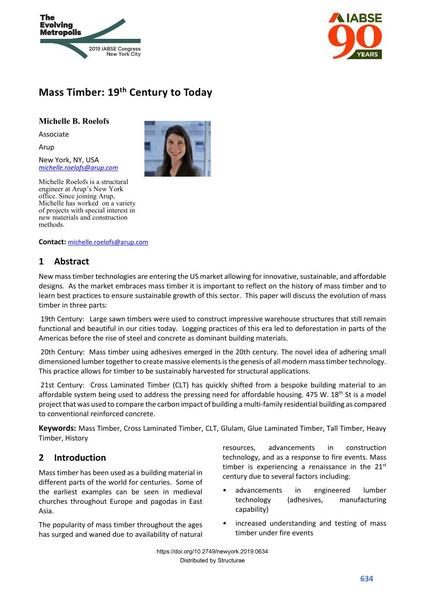Mass Timber: 19 Century to Today

|
|
|||||||||||
Bibliografische Angaben
| Autor(en): |
Michelle B. Roelofs
(Arup)
|
||||
|---|---|---|---|---|---|
| Medium: | Tagungsbeitrag | ||||
| Sprache(n): | Englisch | ||||
| Tagung: | IABSE Congress: The Evolving Metropolis, New York, NY, USA, 4-6 September 2019 | ||||
| Veröffentlicht in: | The Evolving Metropolis | ||||
|
|||||
| Seite(n): | 634-640 | ||||
| Anzahl der Seiten (im PDF): | 7 | ||||
| DOI: | 10.2749/newyork.2019.0634 | ||||
| Abstrakt: |
New mass timber technologies are entering the US market allowing for innovative, sustainable, and affordable designs. As the market embraces mass timber it is important to reflect on the history of mass timber and to learn best practices to ensure sustainable growth of this sector. This paper will discuss the evolution of mass timber in three parts: 19th Century: Large sawn timbers were used to construct impressive warehouse structures that still remain functional and beautiful in our cities today. Logging practices of this era led to deforestation in parts of the Americas before the rise of steel and concrete as dominant building materials. 20th Century: Mass timber using adhesives emerged in the 20th century. The novel idea of adhering small dimensioned lumber together to create massive elements is the genesis of all modern mass timber technology. This practice allows for timber to be sustainably harvested for structural applications. 21st Century: Cross Laminated Timber (CLT) has quickly shifted from a bespoke building material to an affordable system being used to address the pressing need for affordable housing. 475 W. 18thSt is a model project that was used to compare the carbon impact of building a multi-family residential building as compared to conventional reinforced concrete. |
||||
| Stichwörter: |
Geschichte
|
||||
